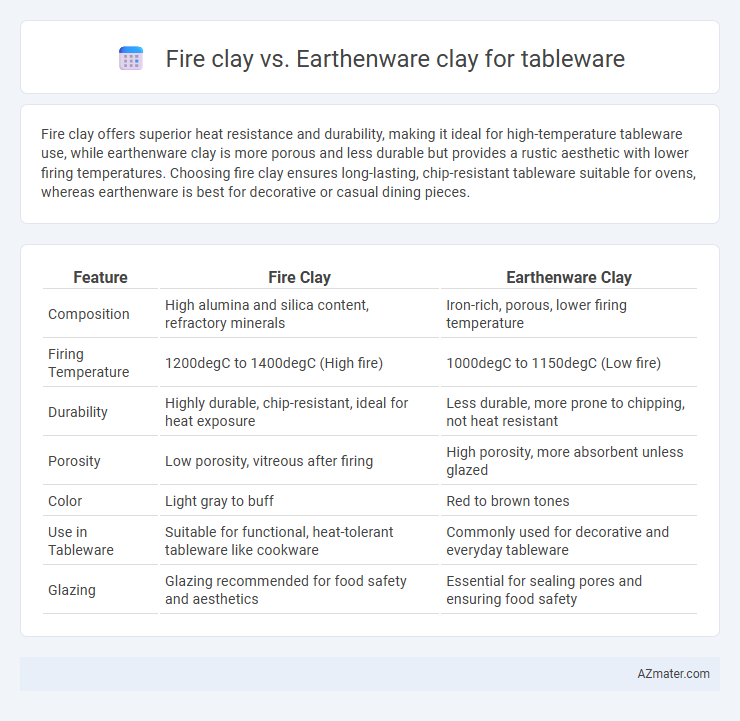Fire clay offers superior heat resistance and durability, making it ideal for high-temperature tableware use, while earthenware clay is more porous and less durable but provides a rustic aesthetic with lower firing temperatures. Choosing fire clay ensures long-lasting, chip-resistant tableware suitable for ovens, whereas earthenware is best for decorative or casual dining pieces.
Table of Comparison
| Feature | Fire Clay | Earthenware Clay |
|---|---|---|
| Composition | High alumina and silica content, refractory minerals | Iron-rich, porous, lower firing temperature |
| Firing Temperature | 1200degC to 1400degC (High fire) | 1000degC to 1150degC (Low fire) |
| Durability | Highly durable, chip-resistant, ideal for heat exposure | Less durable, more prone to chipping, not heat resistant |
| Porosity | Low porosity, vitreous after firing | High porosity, more absorbent unless glazed |
| Color | Light gray to buff | Red to brown tones |
| Use in Tableware | Suitable for functional, heat-tolerant tableware like cookware | Commonly used for decorative and everyday tableware |
| Glazing | Glazing recommended for food safety and aesthetics | Essential for sealing pores and ensuring food safety |
Introduction to Tableware Clays
Fire clay and earthenware clay serve distinct roles in tableware production due to their varying thermal properties and strength. Fire clay, with high refractory resistance, withstands extreme temperatures, making it ideal for durable, heat-resistant tableware used in ovens and microwaves. Earthenware clay, softer and more porous, offers a rustic aesthetic but requires glazing to ensure food safety and durability in everyday table settings.
What is Fire Clay?
Fire clay is a heat-resistant clay composed mainly of kaolinite and other silicate minerals, making it ideal for high-temperature applications such as tableware firing. It offers superior durability and thermal shock resistance compared to earthenware clay, which is more porous and fired at lower temperatures. Fire clay's dense composition ensures that tableware remains strong, chip-resistant, and safe for everyday use, especially under repeated exposure to heat.
What is Earthenware Clay?
Earthenware clay is a porous, low-fire clay body known for its rich textures and warm colors, typically fired between 1,000degC and 1,150degC. This type of clay is softer and more porous than fire clay, making it less durable but ideal for decorative tableware with vibrant glazes. While fire clay offers higher strength and thermal resistance for functional cookware, earthenware remains favored for its aesthetic appeal and ease of shaping in artisanal tableware production.
Key Properties of Fire Clay
Fire clay offers high refractoriness and exceptional durability, making it ideal for tableware that withstands thermal shock and heavy use. Its dense, fine-grained composition provides superior strength and resistance to chipping compared to earthenware clay, which is more porous and fragile. Fire clay's low water absorption enhances its suitability for functional, everyday tableware requiring long-lasting performance and minimal wear.
Key Properties of Earthenware Clay
Earthenware clay is characterized by its porous nature and lower firing temperature, typically between 1000degC and 1150degC, which makes it less durable but more workable than fire clay. It is softer and more absorbent, requiring a glaze to achieve water-tightness and suitable for decorative tableware with vibrant glaze finishes. Compared to fire clay, earthenware offers a warmer, more rustic aesthetic but with reduced resistance to chipping and thermal shock.
Durability: Fire Clay vs Earthenware Clay
Fire clay is highly durable, offering excellent resistance to thermal shock and mechanical wear, making it ideal for tableware subjected to frequent use and temperature changes. Earthenware clay, while aesthetically versatile, is more porous and less durable, often requiring glazing to improve strength and prevent chipping. When comparing durability for tableware, fire clay consistently outperforms earthenware clay due to its denser composition and higher firing temperature.
Porosity and Water Absorption Comparison
Fire clay exhibits significantly lower porosity and water absorption rates compared to earthenware clay, making it more durable and suitable for tableware that requires resistance to moisture and staining. Earthenware clay typically has higher porosity, resulting in increased water absorption unless it is properly glazed, which can affect the longevity and maintenance of tableware items. Selecting fire clay for tableware enhances resistance to liquid penetration, ensuring better performance in everyday use and dishwasher safety.
Aesthetic Qualities and Color Variations
Fire clay offers a dense, stone-like texture with warm, earthy hues ranging from deep reds to muted browns, ideal for rustic or industrial-style tableware. Earthenware clay provides a softer, more porous surface with a broader color palette, including whites, reds, and buff tones that lend an artisanal, handcrafted appearance. The color variation in earthenware allows for more diverse glazing techniques, enhancing tableware aesthetics with vibrant or matte finishes.
Suitability for Everyday Tableware
Fire clay offers superior durability and high resistance to thermal shock, making it ideal for everyday tableware subjected to frequent use and temperature changes. Earthenware clay, while more porous and less robust, provides a rustic aesthetic but may require glazing to ensure water resistance and longevity. For practical, long-lasting tableware, fire clay is generally more suitable due to its strength and low absorption rate.
Conclusion: Choosing the Right Clay for Tableware
Fire clay offers superior durability and heat resistance, making it ideal for tableware subjected to frequent use and thermal stress. Earthenware clay provides a more porous and rustic aesthetic but generally requires glazing to ensure food safety and durability. Selecting the right clay depends on balancing functional demands with desired visual qualities, where fire clay suits longevity and practicality, while earthenware favors artistic and traditional appeal.

Infographic: Fire clay vs Earthenware clay for Tableware
 azmater.com
azmater.com